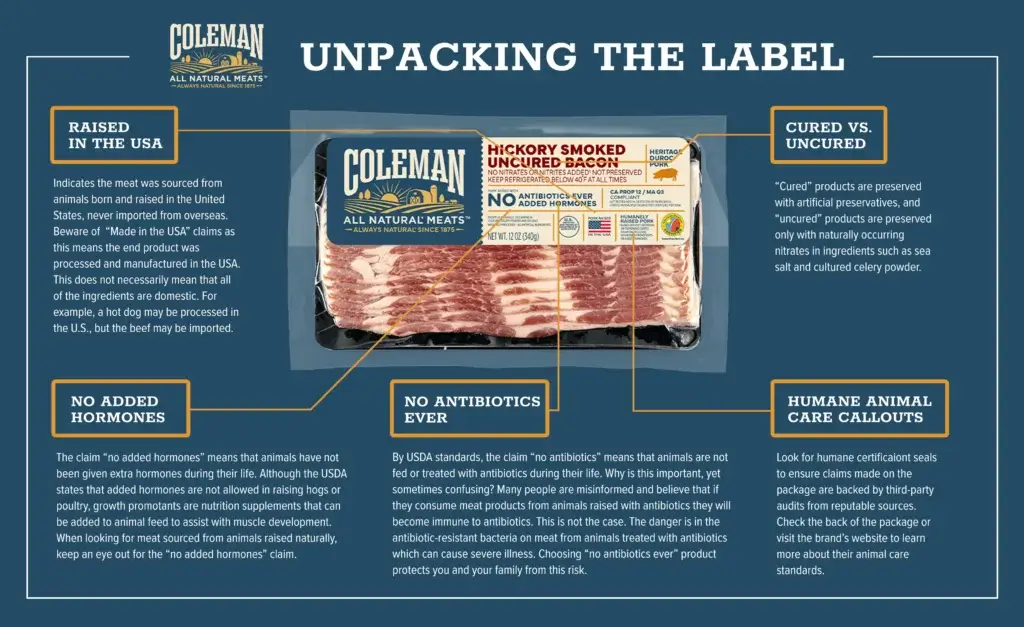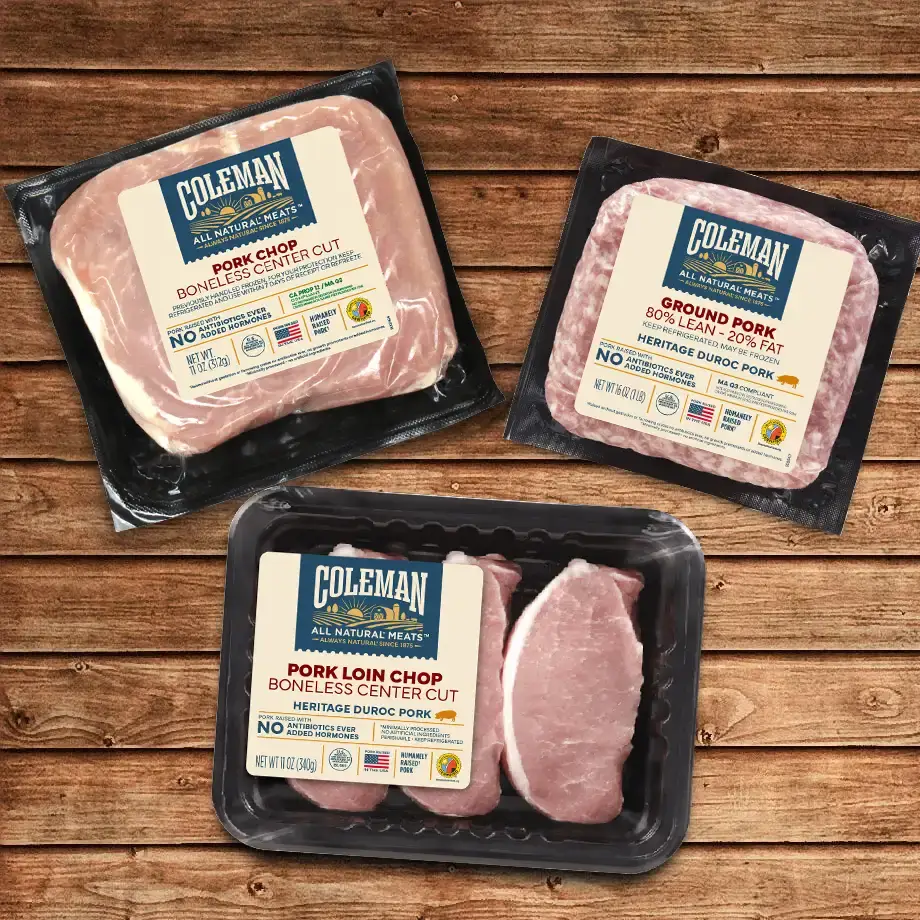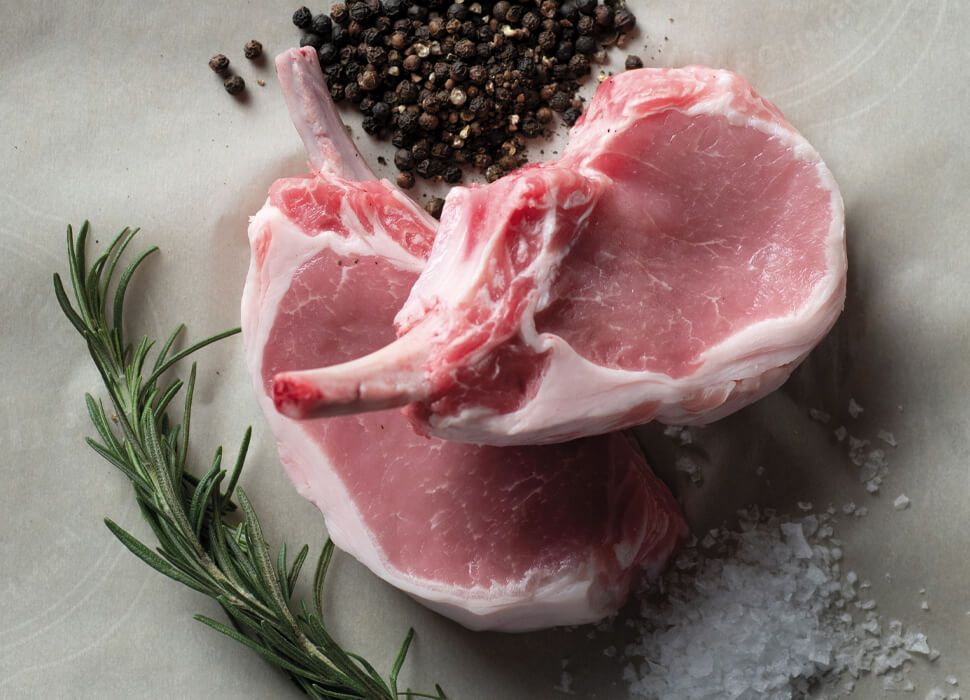Being a conscious consumer isn’t easy when you don’t recognize what you’re reading on a product label. Understanding meat labels can be especially confusing. When looking at a vast display of meat, how do you choose the right one?
To really feel confident about what you’re feeding your family, you need to understand the types of statements and claims that are made on a meat label. This will help you find the highest-quality products and make the right decisions about the food you purchase. For example, here at Coleman Natural Foods, we ensure that our “all-natural,” no added hormones or artificial ingredients standards reflect what’s listed on the label.
We want to make this easier for you by breaking down everything you may see on a meat label, and what it all means.
What Common Meat Label Statements Mean
Meat labels can be packed with claims and statements about the quality of a product and its ingredients. Americans are more concerned with understanding meat labels than they’ve ever been. Here are a few common terms you’ll see on a meat label and what they mean:

Raised In The USA
“Raised in the USA” means that the meat was sourced from animals born and raised in the United States—never imported from overseas. Coleman Natural sources all of its meat from independent American family farms.
For example, Tim Brandt from Brandt Swine Farms started partnering with Coleman Natural Foods back in 2013. Since then, he’s instilled a crate-free system and vegetarian diet for all animals raised on his farm.
“What we do takes a lot of animal husbandry, or care for the animals. We keep an eye on them, we know them and it results in happier pigs and overall better meat. It’s certainly not the easy way, but it’s important not only to my family but to today’s consumer.”
Tim Brandt from Brandt Swine Farms
Made In The USA
“Made in the USA” means the end product was processed and manufactured in the USA. This does not necessarily mean that all of the ingredients are domestic. For example, a hot dog may be processed in the U.S., but the beef may be imported.
Cured And Uncured
“Cured” products are preserved with artificial or chemical preservatives, and “uncured” products are preserved only with naturally occurring nitrates in ingredients such as sea salt and cultured celery powder. All Coleman Natural products are uncured—ensuring you always cook with healthier and simpler products.
No Artificial Ingredients
If you see “no artificial ingredients” on a meal label, this means that no “unnatural” ingredients or colorants were added to the meat. Furthermore, most brands who make this claim minimally process or alter products. Coleman Natural always strives to keep the ingredient list as simple as possible—never adding artificial ingredients.
No Antibiotics
By USDA standards, the claim “no antibiotics” means that animals are not fed or treated with antibiotics during their life. This refers to all antibiotics, including medically important antibiotics, and those that could contribute to resistance in humans. The meat you purchase from Coleman Natural never comes from animals that have been given antibiotics at any time in their life.
No Added Hormones
The claim “no added hormones” means that animals have not been given extra hormones during their life. Although the USDA states that added hormones are not allowed in raising poultry, growth promotants are nutritional supplements that can be added to animal feed to assist with muscle development. Coleman Natural promises to never add hormones or growth promotants when raising animals.
Always do additional research into a brand’s statements to see for yourself what a claim means to them. Simple packaging, like that on Coleman Natural products, makes it easy to track down all of this information. You can read about our product claims on our website.

Breaking Down Certifications
Meat producers use different third-party authorities to certify the claims they make about their products as an added layer of trust for shoppers. Some certifications indicate that meat is free of additives and artificial ingredients, and others indicate that animals were treated humanely.
According to a national survey by American Humane, more than 9 in 10 consumers are concerned about farm animal welfare and look for humane certification labels on their food and meat labels.
Coleman Natural products, for example, are labeled American Humane Certified™. This means that farmers must meet at least 200 scientific standards for humane animal care. The American Human certification is based on the Five Freedoms, a worldwide measure of animal care that “goes beyond the basics of food, water, shelter, and health to include freedom from distress and the freedom to express normal behaviors.”
If you ever see an unfamiliar certification, we advise you to do your own research. Find out more about the certifying body giving the certification to ensure their practices and standards align with your values and expectations for the meat you feed your family.

Watch Out for These Red Flags
When understanding meal labels, there are a few red flags you can look for to avoid low-quality products.
Pay Attention to the Ingredients List
Ingredients or preservatives with names you can’t pronounce may be chemical additives. Scan for anything artificial, from artificial coloring to artificial sweeteners. The ingredients should look like real food.
Avoid Processed Meat Products
It’s best to refrain from processed meat products that are not 100% a single protein unless it is clearly stated as a combination product containing multiple proteins, such as beef and pork. Other protein fillers are often added to meat products to bulk them up and lower the cost of production. These fillers may be low-quality meat products or plant-derived binders such as soy lecithin.
Check for Animal Welfare Details
Be wary of meat labels that contain little to no information about how animals are raised, or about the use of hormones and other stimulants. This information should be easy to identify on a meat label; if it’s not, you might want to steer clear. We put this information on all Coleman Natural packaging, front and center.

What To Look For on Meal Labels
So what should you look for on a meat label? You want to see that a product is all-natural.
Although “natural” is defined by the United States Department of Agriculture as minimally-processed and containing no artificial ingredients, some brands stick to the minimum requirements, while others–like Coleman–far exceed these standards.
“Natural to us is based on what we believe. We didn’t get into the business based on some market data that said ‘you should do this because you’ll make a lot of money.’”
Mel Coleman, Jr.
How Coleman Natural Takes All-Natural to a New Level
Today, the USDA requirement is much less stringent, but Coleman Natural continues to hold to the highest standards of crate-free, humane animal-raising practices. All Coleman Natural products including our fresh pork, pork sausages, ham, bacon, and all-beef hot dogs are all-natural. To us, this means a few key things, which you’ll see on every label:
- No Antibiotics Ever—you’ll never be eating meat that comes from an animal that was treated with antibiotics at any point in its life.
- No Artificial Ingredients—we never add chemicals or colorants to our products—always ensuring simple ingredients you recognize.
- No Added Hormones—we let our animals grow naturally without the help of growth hormones or promotants.
- Raised in the USA—our livestock is raised by American family farmers.
- Crate-Free—our hogs don’t spend any portion of their lives in crates and are free to interact with each other and their piglets as nature intended. We provide 114% more space than average industry farrowing crates.
You can advocate for the causes you care about by being intentional about the meat you purchase. Coleman Natural uses ingredients that can ensure optimal health for you and your family.
Ready to dive into more articles like this? Read these next!
- What Does “Natural” Mean on a Meat Label?
- What is the Difference Between Cured & Uncured Bacon?
- What Are Hot Dogs Made of and Why Does it Matter?
This article was originally published on June 23, 2021, and has since been updated.


